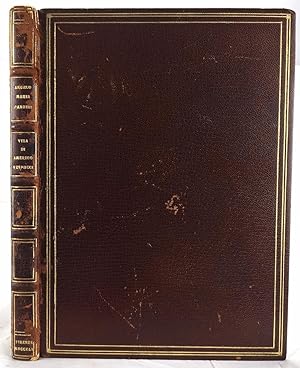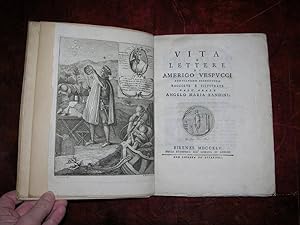Vespucci Amerigo Bandini Angelo Maria (2 results)
Product Type
- All Product Types
- Books (2)
- Magazines & Periodicals
- Comics
- Sheet Music
- Art, Prints & Posters
- Photographs
- Maps
-
Manuscripts &
Paper Collectibles
Condition
- All Conditions
- New
- Used
Binding
- All Bindings
- Hardcover (1)
- Softcover
Collectible Attributes
- First Edition (1)
- Signed
- Dust Jacket
- Seller-Supplied Images
- Not Printed On Demand
Seller Location
Seller Rating
-
Vita e Lettere di Amerigo Vespucci Gentiluomo Fiorentino Raccolte e Illustrate dall' Abate Angelo Maria Bandini
Published by Firenze, Stamperia all'insegna di Apollo, 1745
Book
Hardcover. Condition: Very Good. Quarto. lxxvi, 128, 1 pl. [1] pp. Bound in early modern red Moroccan leather. Gilt spine and rule. Marbled endpapers. AEG. Light wear to boards. Rubbing and chipping wear to spine. Lacks the folding genealogical table. Internally well persevered with clean, unmarked pages. First edition of a critical and landmark biography of Amerigo Vespucci, the navigator after whom America is named, depicting the life of Amerigo Vespucci, including his letters describing alleged voyages to America. Also includes Girolamo Sernizi's account of Vasco da Gama's journey. Described by Sabin as "an elaborate panegyric of Vespucius, in which he is called the Discoverer of America. "This classic work is much sought after. It can be affirmed that the book's publication inflamed the literary controversy about Vespucci that impassioned the greatest 'Americanists' of ensuing decades. It is an indispensable work, a true landmark in Vespucian studies" - Borba de Moraes. Sabin 3149; Borba de Moraes, p 68; Alden/Landis 745/218; Palau 23255.
-
Vita e Lettere di Amerigo Vespucci Gentiluomo Fiorentino Raccolte e Illustrate dall' Abate Angelo Maria Bandini .
Published by Florence: Stamperia All' Insegna de Apollo, 1745., 1745
Seller: Arader Galleries - AraderNYC, New York, NY, U.S.A.
First Edition
Small 4to., (9 4/8 x 7 inches). Engraved vignette on the title page. Engraved frontispiece by Menabuoni after Sveicarte, fine folding engraved chart of the Vespucci genealogy, woodcut diagram in the text showing a globe surrounded by a celestial sphere (short marginal tear), engraved head- and tail-pieces, initials. Early 20th- century vellum over paste-board by Pratt for H. Stevens, black morocco lettering-piece on the spine, small floral device stamped in blind in the centre of the front cover, uncut. Provenance: early shelf-marks on the front paste-down. "AN ELABORATE PANEGYRIC OF VESPUCIUS, IN WHICH HE IS CALLED THE DISCOVERER OF AMERICA" (Sabin) First edition of an extremely important biography of Amerigo Vespucci, the navigator after whom America is named, and printing the four letters attributed to Vespucci recounting his four voyages. Vespucci's "fame in his own time rested on two works that bore his name, usually known as the Mundus Novus and the Soderini Letter. The first was an enormous popular success, probably first printed in Florence in 1503-1504, though the earliest dated edition is of 1504, from Otmar of Augsburg. Despite overlaps with four manuscript accounts (reliably ascribed to Vespucci) of the Ojeda voyage and the Coelho voyage of 1501, these printed works cannot be definitely pronounced authentic. In any case, all of Vespucci's narratives belong to a twilight zone between history and travel literature and cannot be treated as literal truth. Estimates of distance traversed and latitude attained have to be taken as exaggerations. "Under the impact of the printed accounts, Martin Waldseemüller, the influential cosmographer of St. Dié, hailed Vespucci as the modern Ptolemy and proposed that the New World should be named America in his honor. Though Waldseemüller withdrew the suggestion in 1513, acknowledging Columbus's prior and superior claims, the name stuck. The belief that Vespucci was the first to use the name "New World" is erroneous: if the phrase was indeed his, Columbus and Peter Martyr had probably preceded him in using it; nor is it true that he was the first to recognize the continental dimensions of Columbus's discoveries or their distinctness from Asia. Columbus had identified South America as a continent in 1498, and Vespucci's own writings reproduce a worldview very like Columbus's, including the belief that the New World was close to or contiguous with Asia" (Felipe Fernández-Armesto for ANB). Catalogued by Kate Hunter.



